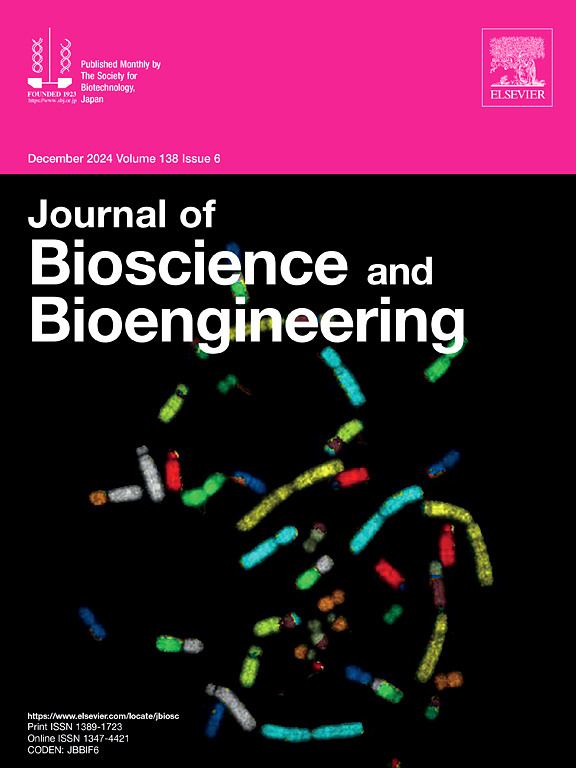Metabolic profiling reveals distinctive ripening dynamics in ethylene-treated Musa balbisiana cv. ‘Pisang Klutuk Wulung’ compared to commercial Cavendish banana
IF 2.9
4区 生物学
Q3 BIOTECHNOLOGY & APPLIED MICROBIOLOGY
引用次数: 0
Abstract
As an important crop, bananas still encounter fruit quality and shelf-life problems that are affected by the ripening process. Improving postharvest technologies may effectively address these challenges, such as by studying the ripening mechanism of banana cultivars with a slow ripening process. A banana cultivar that exhibits this characteristic is Musa balbisiana cv. ‘Pisang Klutuk Wulung’ (BB Group) or Pisang Klutuk Wulung (PKW), which has a ripening duration of 14–28 days. However, the metabolomics study on the ripening mechanism of this banana is still limited. This study aimed to analyze metabolite changes in ethylene-treated Pisang Klutuk Wulung during ripening in comparison to commercial bananas (Cavendish). Both bananas were subjected to exogenous ethylene treatment and analyzed using gas chromatography-mass spectrometry to perform metabolite profiling throughout the ripening process. The principal component analysis showed sample separation based on the ripening stages and banana species in pulp and peel. Orthogonal projection to latent structure analysis suggested that metabolite changes accompanied the ripening stages. Potential metabolite markers that distinguished the ripening of PKW and Cavendish were found, such as quinic acid, inositol, and 2-aminoethanol. This study shows differences in metabolite profiles between these bananas, especially the metabolites involved in sugar metabolism, cell wall metabolism, stress response, and biosynthesis of aromatic compounds. This study provides novel insights into the metabolic changes occurring during PKW ripening, contributing to the improvement of banana postharvest strategies.

代谢分析揭示了乙烯处理芭蕉独特的成熟动力学。“Pisang Klutuk Wulung”与商业卡文迪什香蕉相比。
香蕉作为一种重要的作物,其果实质量和保质期仍然受到成熟过程的影响。改进采后技术可以有效地解决这些挑战,例如研究成熟过程缓慢的香蕉品种的成熟机制。表现出这种特征的香蕉品种是芭蕉。‘Pisang Klutuk Wulung’(BB Group)或Pisang Klutuk Wulung (PKW),成熟期为14-28天。然而,对这种香蕉成熟机制的代谢组学研究仍然有限。本研究旨在分析乙烯处理的Pisang Klutuk Wulung在成熟过程中与商业香蕉(Cavendish)的代谢物变化。两种香蕉都受到外源乙烯处理,并使用气相色谱-质谱分析在整个成熟过程中进行代谢物分析。主成分分析表明,香蕉果肉和果皮的成熟阶段和香蕉种类是样品分离的依据。正交投影-隐结构分析表明,代谢物随成熟期的变化而变化。发现了区分PKW和卡文迪什成熟的潜在代谢物标记,如奎宁酸、肌醇和2-氨基乙醇。本研究显示了这些香蕉之间代谢物谱的差异,特别是涉及糖代谢、细胞壁代谢、应激反应和芳香化合物生物合成的代谢物。该研究为PKW成熟过程中的代谢变化提供了新的见解,有助于香蕉采后策略的改进。
本文章由计算机程序翻译,如有差异,请以英文原文为准。
求助全文
约1分钟内获得全文
求助全文
来源期刊

Journal of bioscience and bioengineering
生物-生物工程与应用微生物
CiteScore
5.90
自引率
3.60%
发文量
144
审稿时长
51 days
期刊介绍:
The Journal of Bioscience and Bioengineering is a research journal publishing original full-length research papers, reviews, and Letters to the Editor. The Journal is devoted to the advancement and dissemination of knowledge concerning fermentation technology, biochemical engineering, food technology and microbiology.
 求助内容:
求助内容: 应助结果提醒方式:
应助结果提醒方式:


